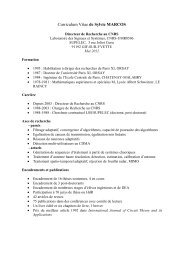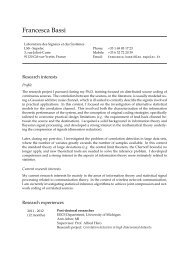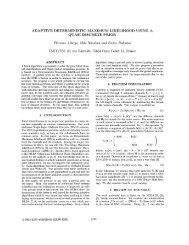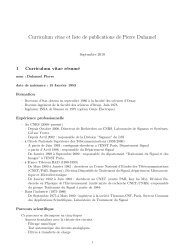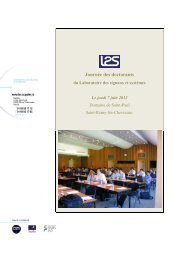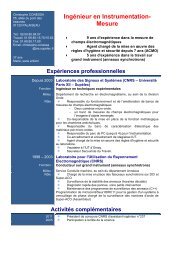THÈSE DE DOCTORAT Ecole Doctorale « Sciences et ...
THÈSE DE DOCTORAT Ecole Doctorale « Sciences et ...
THÈSE DE DOCTORAT Ecole Doctorale « Sciences et ...
Create successful ePaper yourself
Turn your PDF publications into a flip-book with our unique Google optimized e-Paper software.
Annexe D. Théorèmes du p<strong>et</strong>it gain pour des systèmes paramétrés 185<br />
On définit les fonctions de classe K ν x ,ν u , pour s ∈ R ≥0 :<br />
ν x (s) = max { β 1 (ρ 1 (s),0),γ ωa 2<br />
1 (β 2(ρ 2 (s),0)),ρ 1 (s),β 2 (ρ 2 (s),0),γ ω 1<br />
2 (β 1(ρ 1 (s),0)),<br />
˜β(s,0),s }<br />
ν u (s) = max { γ u 1 (s),γωa 2<br />
1 ◦ γ u 2 (s),γu 2 (s),γω 1<br />
2 ◦ γ u 1 (s),˜γu (s) } ,<br />
où ˜β ∈ KL, ˜γ u ∈ K sont définies respectivement par (D.74) <strong>et</strong> (D.78), <strong>et</strong> soit ∆ ∈ R >0 tel<br />
que max { ν x (∆),ν u (∆) } < M.<br />
Alors, le système (D.46)-(D.47) est uniformément positivement compl<strong>et</strong> pour tout (x 1 (t 0 ),<br />
x 2 (t 0 )) ∈ R nx 1 +nx 2 <strong>et</strong> (u 1 ,u 2 ) ∈ L nu 1 +nu 2<br />
∞ avec max { |x 1 (t 0 )|,|ω a 2 (x 2(t 0 ))|, ‖u 1 ‖ ∞<br />
, ‖u 2 ‖ ∞<br />
}<br />
<<br />
∆. De plus, pour tout η > 1, il existe β ∈ KL , σ ∈ K telles que pour tout (x 1 (t 0 ),x 2 (t 0 )) ∈<br />
R nx 1 +nx 2 <strong>et</strong> (u 1 ,u 2 ) ∈ L nu 1 +nu 2<br />
∞ avec max { |x 1 (t 0 )|,|ω2 a(x }<br />
2(t 0 ))|, ‖u 1 ‖ ∞<br />
, ‖u 2 ‖ ∞ < ∆, les<br />
solutions de (D.46)-(D.47) satisfont, pour tout t ≥ t 0 ≥ 0,<br />
{<br />
max { |ω 1 (x 1 (t))|,|ω a 2 (x 2(t))| } ≤ max<br />
où δ(s) = max { η˜σ m (s),ηs } , pour s ∈ R ≥0 .<br />
β(max { |ω 1 (x 1 (t 0 ))|,|ω a 2 (x 2(t 0 ))| } ,t − t 0 ),<br />
σ(max { ‖u 1 ‖ [t0 ,t) , ‖u 2‖ [t0 ,t)<br />
}<br />
),δ(m)<br />
}<br />
, (D.58)<br />
Preuve. Il est tout d’abord prouvé que le système est uniformément positivement compl<strong>et</strong><br />
lorsque les conditions initiales <strong>et</strong> les entrées (u 1 ,u 2 ) ∈ L nu 1 +nu 2<br />
∞ sont convenablement majorées.<br />
La propriété de stabilité désirée est ensuite obtenue en invoquant la Proposition D.1.3.<br />
Etape 1. Complétude positive <strong>et</strong> majoration de ω 1 (x 1 ) <strong>et</strong> ω a 2 (x 2).<br />
Soient t 0 ∈ R ≥0 , (x 1 (t 0 ),x 2 (t 0 )) ∈ R nx 1 +nx 2 <strong>et</strong> (u 1 ,u 2 ) ∈ L nu 1 +nu 2<br />
∞<br />
tels que<br />
max { |x 1 (t 0 )|,|ω a 2(x 2 (t 0 ))|, ‖u 1 ‖ ∞<br />
, ‖u 2 ‖ ∞<br />
}<br />
< ∆, (D.59)<br />
ce qui implique, d’après la définition de ∆,<br />
ν x (max { |x 1 (t 0 )|,|ω a 2(x 2 (t 0 ))| } ) < M (D.60)<br />
ν u (max { ‖u 1 ‖ [t0 ,∞) , ‖u 2‖ [t0 ,∞)<br />
}<br />
) < M. (D.61)<br />
Soit [t 0 ,t max ) l’intervalle maximal d’existence de (D.46)-(D.47), où t max ∈ (t 0 ,∞]. De par<br />
(D.52) <strong>et</strong> (D.54), on a, pour tout t ∈ [t 0 ,t max ) :<br />
{<br />
|ω 1 (x 1 (t))| ≤ max β 1 (|ω 1 (x 1 (t 0 ))|,t − t 0 ),γ ωa 2<br />
1 (β 2(|ω2(x a 2 (t 0 ))|,0)),<br />
γ ωa 2<br />
1 (γω 1<br />
2 (‖ω 1(x 1 )‖ [t0 ,t) )),γωa 2<br />
1 (γu 2 (‖u 2 ‖ [t0 ,t)<br />
}<br />
)),<br />
γ1 u (‖u 1‖ [t0 ,t) ) {<br />
‖ω 1 (x 1 )‖ [t0 ,t)<br />
≤ max β 1 (|ω 1 (x 1 (t 0 ))|,0),γ ωa 2<br />
1 (β 2(|ω2(x a 2 (t 0 ))|,0)),<br />
γ ωa 2<br />
1 (γω 1<br />
2 (‖ω 1(x 1 )‖ [t0 ,t) )),γωa 2<br />
1 (γu 2 (‖u 2‖ [t0 ,t) )),<br />
(D.62)<br />
γ u 1 (‖u 1‖ [t0 ,t) ) }. (D.63)



